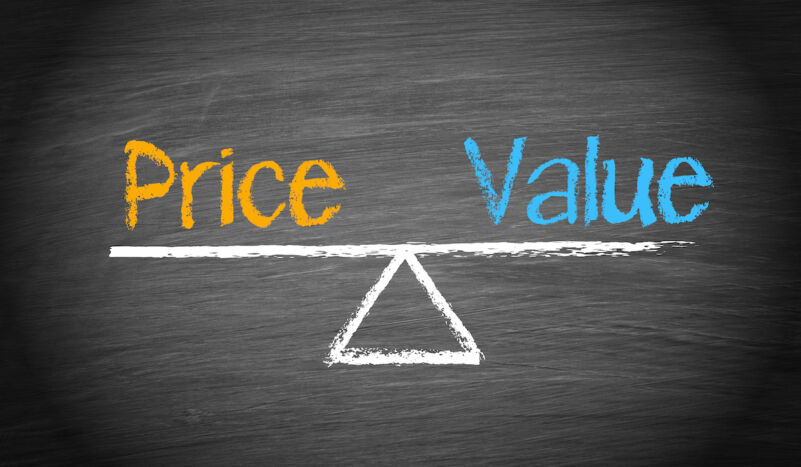Do you charge all your customers the same price? Be honest here. And did you reach that price by looking at your costs-in and adding a healthy margin? This form of cost-based pricing is pretty common. We find it in most businesses when we start coaching them, particularly when they sell commodities.
But by doing this, you’re missing a trick. Credit must go to Blair Enns for his book ‘Pricing Creativity: A Guide to Profit Beyond the Billable Hour.’ In it, he articulates a view beautifully that I have held for some time. If you want to scale your business quickly, you need to charge based on the value your company represents to customers rather than cost.
‘That’s all very well,’ you may say. ‘But how?’ Let me give you some suggestions.
Get your customer to articulate their problem properly.
When you first sit down with a customer, it won’t take long before they ask you for a price. Resist the urge to jump in with specific figures. Tell them you work differently. You can’t give a price until you’ve worked out exactly what it’s worth to them.
I’ve embedded this step into my consultative selling methodology. As part of this, I suggest getting the customer to dig into their business model and tell me the challenges that they’re facing in their own words. But I also get them to articulate the value of solving this problem. We recently did this with a prospective CEO client who told us that if they could improve their six-month customer retention by 5%, it would be worth $10 million to them over the next three years. There it was. A clear understanding of our coaching services’ value and a starting point to determine a cost.
Last week, I was coaching a client Executive Team on value-based pricing. They wanted to add £500K of revenue from services to their topline next year. I suggested they could do this by changing how they price new customers. They told me that two-thirds of the projects they pick up have already failed somewhere else with a different supplier. So again, there’s something they can factor into the value they offer if they solve the customer’s issue.
Sell the vision to your customers.
As part of these initial conversations, you’re asking your customer, where are they trying to get to? If, in the future, they have solved their problem, where will it take their business? Sell the vision of their future state.
When I think about the CEO clients we work with, they often have an immediate challenge that’s holding them back. But more than that, they have a future growth state in their minds. They’ll say, ‘Well – if I don’t get any help, maybe I go from £10 million to £14 million in three years. But if you can help me, maybe we could go from £10-£20 million in the same period.’ In this situation, I would reply, ‘OK – so my help is worth £6 million to you over the next three years.’
The way I price is no more than 10% of the upside. Their perceived value out of the deal over three years needs to be at least ten times what I’m charging them. The example I’ve given above equates to a cost of £200K for an annual upside of £2 million. Then they see my cost as an investment. And it gives a margin for error. Even if we only achieve three or four times the value, it will be a success.
Find a metric

Once you’ve established the value you can bring to the customer’s business, you need to decide how to measure this. This is important. I would say to my fictional client above, ‘It’s £14 million turnover in three years if you do this by yourself but £20 million if I help you. So, let’s find a gross profit number and determine what will drive that profit.’ This could be the sale of a new product or market penetration. We’ve previously worked with several clients who want to open in the UK. They’re attracted to my expertise and track record scaling tech companies in the UK. This is where having me as a business coach adds value. Alternatively, the metric could be increasing profit through efficiency improvements. Work out these efficiency areas and a specific number you can track.
Then you can map out the next three years. Identify what’s going to change and where you will be needed. Once you have a metric, you can work out where you want to be at the end of Years 1, 2 and 3. You can lay out your process to the customer. Tell them how you will obsess about this metric. At the end of year 1, you will look back to ensure you’ve made the progress you wanted. This will reassure your customer that you will deliver on your promise. It will also help them understand the value their investment is bringing.
Create an anchor
One of our clients is starting a new business aiming to get from zero to £50 million in three years. In this situation, I have told them I won’t charge more than 10% of the upside. ‘What?! You’re going to charge us £5 million?’ they exclaimed. No. The final cost will be significantly less than this. But I want to anchor their understanding of the value I will bring them. Whatever I charge, there will be a perception that it’s worth the money.
Alternatively, I might say our cost will be between x and y. You’re early on in your relationship, and you’ve created some value. You want to be able to pitch to see whether it’s worth doing anything else for them. There’s no point doing proposals for someone who isn’t going to buy. Get agreement that the value you’ve identified is true and articulate the rough ballpark costs to solve this problem. If you agree to these, you can move forward with a proposal. And if they disagree, say goodbye. A ‘no’ is as good as a ‘yes’ in this situation. You don’t want to waste your time.
Price according to the expertise you offer
An insightful quote from Blair Enns is relevant here, ‘Expertise is the only valid basis for differentiating ourselves from the competition. Not personality. Not process. Not price. When the client has few alternatives to our expertise, we can dictate pricing, set the terms of the engagement, and take control.’
Position your business as the only solution to the customer’s problem. Back to the client who wants to add £500K to their topline, the customers they work with are some of the largest in the world – Fortune 1000 businesses that are doing massive projects. Our client is very specialised. Forget an inch wide and a mile deep. Their niche is 1mm wide and 10km deep! I suspect they’re finding it hard to drive up revenue because they are underquoting.
Remember, the price can often set the value. And there’s real, measurable value in the expertise of your brand. Think of Hermes handbags. Are they more valuable than the leather and the stitching? You bet they are! Be aware a low price can be an indicator of low value or quality in people’s minds.
Offer a menu of pricing options or consultative workshops.
Once you’ve worked out the value to your customer of solving their problem and a metric to measure, consider presenting a series of standard options to which they can tier up. So when you put forward your proposal, you can offer them three possible costs. They will likely choose the middle option but give them 1 and 3 if they decide to spend more or save money. Only this morning, I was talking to a fellow coach who had done this and, for the first time, someone had picked option 1 – his most expensive. He was pretty pleased!
Another option is to create a workshop. This was the solution we came up with for the client with Fortune 1000 customers. They found they were a long way down the value chain when a customer engaged them. And the customer was asking them for a price for a commodity.
So we designed a service offering – a workshop. This is non-negotiable. Every one of their new customers needs to attend this if they want to engage them. Here, they can have a value-based conversation to work through all the stuff the client has done themselves. The customer may think this is rock solid, but our client knows from experience it’s likely to be poorly thought through. This will lay out the potential downside of cocking things up, which is worth more to their customer than the commodity’s price.
At the workshop, our client can lay out their expertise gained from working with other companies with similar challenges. They know where things will go wrong. The customer may think they’ve done all the early work necessary. But invariably, they haven’t. Our client demonstrates their value by creating a helpful workshop that gets them to think more deeply about the project. Hopefully, on the back of this, they will be invited to contribute earlier in the sales process for future projects.
At the beginning of their coaching day with us, this client had no idea where the £500K increase to their topline would come from. By the end of our value-based pricing discussion, it was much clearer. They had several routes. And it wasn’t going to be as challenging as they’d thought.
Written by business coach and leadership coaching expert Dominic Monkhouse. Contact him to schedule a call here. You can order your free copy of his book, Mind Your F**king Business here.

